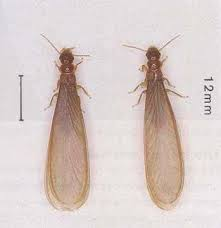Coptotermes acinaciformis
Effective Coptotermes acinaciformis treatment solutions
- We reply within 24 Hours
- Safe, effective treatments

Coptotermes acinaciformis
Effective Coptotermes acinaciformis treatment solutions
- We reply within 24 Hours
- Safe, effective treatments
Coptotermes acinaciformis
Coptotermes acinaciformis
Characteristics
Found all over Australia, the Coptotermes acinaciformis termite resembles a white ant with a length of 5mm to 7mm. It’s caste system includes the queen, king, soldier, worker, and reproductive. Soldiers have brown heads and large jaws, while workers are entirely white. The reproductive or alates have a length of 12mm, are brown in colour, and have four large wings. Regarding the characteristics of these termites, the soldiers are aggressive and make a loud ticking sound when disturbed.
Habitat
The ideal habitat location for mating and setting up of nests, is an environment involving decayed wood in the soil which is considered to be suitable for the alates pair. This termite species builds nests underground, under patios, and below concrete slabs and flooring. They prefer certain trees, such as English oaks, various eucalypts, and peppercorns, particularly in the base of the tree trunk or root crown. In other cases, nests are in stumps, poles, and filled-in verandas where timber is present. There may be formations of sub-colonies in buildings, and members will often pack mud around timber damage.
Lifecycle
Alates are produced in the summertime, and the lifecycle of Coptotermes acinaciformis begins when male and female alates mate, they will then start seeking a location for a new colony. Once there is a suitable place, the queen lays eggs which will hatch into nymphs that will transition for two to three months before becoming adult workers, soldiers, or reproductive. The original queen can lay over 1000 eggs per day. In terms of lifespan, soldiers and workers of this termite species typically live for two to three years.
Eating Habits
Like all termites, the Coptotermes acinaciformis termite feeds on cellulose, usually found in timber framing in homes, buildings, trees, logs, and even in plants. This termite species is willing to travel as far as 50m from its nest to look for food. Amongst all the types of food sources available, eating wood is the most preferred food source by this termite species, and once devoured, the wood will start to have a honeycomb texture and may contain dirt. Out of all the termite species across Australia, the Coptotermes acinaciformis termite is the most destructive, especially since it poses a major threat to any timber structure it comes across.
FAQs About Coptotermes acinaciformis






